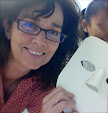It was wonderful talking to everyone yesterday. The scientists thought your questions were very interesting. Katelyn, I’m sorry we didn’t answer your question about how a caterpillar changes into a butterfly. I will ask some of the scientists and record their question on video.
I hope we answered some of your questions about how caterpillars protect themselves. I will try to photograph some of the caterpillars they have here so you can see the different ways they protect themselves. In general, caterpillars who are well camouflaged aren't poisonous. Caterpillars who have spikes and other defenses aren't usually camouflaged.
Today I dissected caterpillars. The scientist, her name is Angela, places glass beads inside live caterpillars. These beads are the same size as the eggs that the wasps lay in the caterpillars. She leaves the beads in for 24 hours and then dissects the caterpillar to get the bead out to see how the caterpillar tried to protect itself. At first, it was really difficult to dissect the caterpillars. The beads are so small you can only see them through the microscope. So I had to look through the microscope while I was dissecting. At first it was very difficult for me. I didn’t think I would be able to do but by the end of the day I did become able to do it. I didn’t give up!
Tomorrow we go to the swamp to collect caterpillars.
skip to main |
skip to sidebar



Dr. Lee Dyer

Pupas





Caterpillar Dissection

Our First Meeting in New Orleans

Come with me as I join a Live From the Field Earthwatch Institute Expedition to New Orleans, September 30 through October 5. What can we learn from the natural defenses of caterpillars and their host plants? What does a warming world mean for the future of moths and butterflies?
Earthwatch LLF Projects



Dr. Lee Dyer

Pupas





Caterpillar Dissection
Blog Archive
Resources
Hunting for Caterpillars

Our First Meeting in New Orleans
About Me

- Melanie DuBose
- I have a BA in Theatre Arts from UCSC and an MFA in Film Production from UCLA. I teach high school English and Directing for Media at East Los Angeles Performing Arts Magnet.

No comments:
Post a Comment